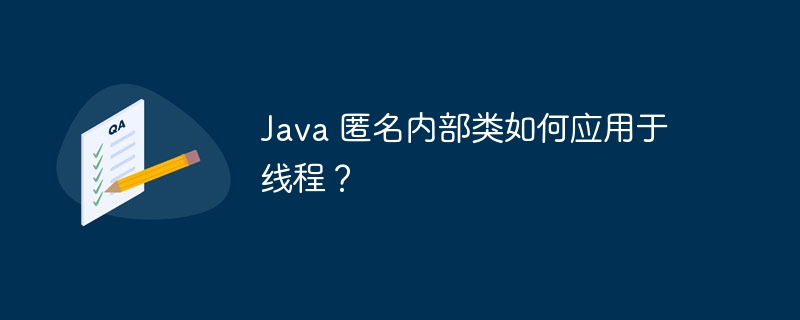How do Java anonymous inner classes apply to threads?
Anonymous inner classes simplify the creation of multi-threaded code without naming, allowing for instant definition and use of thread classes. The main advantage is to simplify the code, while the limitation is that it cannot be extended. Use when you need to quickly create one or two threads. Keep the code short. If more complex logic is required, a separate class file should be created.

Application of Java anonymous inner classes in multi-threading
Java anonymous inner classes can be created directly without naming inner class. It simplifies multithreaded code because thread classes can be defined and used on the fly.
Syntax of anonymous inner classes
new Thread() {
@Override
public void run() {
// 线程逻辑
}
};Practical case: Create and start a thread
// 创建一个匿名内部类线程
Thread thread = new Thread() {
@Override
public void run() {
System.out.println("这是一个新线程。");
}
};
// 启动线程
thread.start();Advantages: Simplify code
Anonymous inner classes can simplify the creation process of thread classes because it does not require the creation of separate class files. This makes it very useful when you need to quickly create a thread or two.
Limitations: Cannot be extended
Anonymous inner classes cannot extend other classes or implement interfaces, so when you need to create reusable or extensible thread classes, they are not best choice.
Best Practice: Keep it Short
Code in anonymous inner classes should be kept short as they can become difficult to maintain and debug. If more complex code is required, it's better to create separate class files.
Conclusion
Java anonymous inner classes provide an easy way for multi-threaded development. They can be very useful when threads need to be created and used quickly. However, for more complex or scalable scenarios, it is better to create separate class files.
The above is the detailed content of How do Java anonymous inner classes apply to threads?. For more information, please follow other related articles on the PHP Chinese website!

Hot AI Tools

Undresser.AI Undress
AI-powered app for creating realistic nude photos

AI Clothes Remover
Online AI tool for removing clothes from photos.

Undress AI Tool
Undress images for free

Clothoff.io
AI clothes remover

AI Hentai Generator
Generate AI Hentai for free.

Hot Article

Hot Tools

Notepad++7.3.1
Easy-to-use and free code editor

SublimeText3 Chinese version
Chinese version, very easy to use

Zend Studio 13.0.1
Powerful PHP integrated development environment

Dreamweaver CS6
Visual web development tools

SublimeText3 Mac version
God-level code editing software (SublimeText3)

Hot Topics
 Square Root in Java
Aug 30, 2024 pm 04:26 PM
Square Root in Java
Aug 30, 2024 pm 04:26 PM
Guide to Square Root in Java. Here we discuss how Square Root works in Java with example and its code implementation respectively.
 Perfect Number in Java
Aug 30, 2024 pm 04:28 PM
Perfect Number in Java
Aug 30, 2024 pm 04:28 PM
Guide to Perfect Number in Java. Here we discuss the Definition, How to check Perfect number in Java?, examples with code implementation.
 Random Number Generator in Java
Aug 30, 2024 pm 04:27 PM
Random Number Generator in Java
Aug 30, 2024 pm 04:27 PM
Guide to Random Number Generator in Java. Here we discuss Functions in Java with examples and two different Generators with ther examples.
 Weka in Java
Aug 30, 2024 pm 04:28 PM
Weka in Java
Aug 30, 2024 pm 04:28 PM
Guide to Weka in Java. Here we discuss the Introduction, how to use weka java, the type of platform, and advantages with examples.
 Armstrong Number in Java
Aug 30, 2024 pm 04:26 PM
Armstrong Number in Java
Aug 30, 2024 pm 04:26 PM
Guide to the Armstrong Number in Java. Here we discuss an introduction to Armstrong's number in java along with some of the code.
 Smith Number in Java
Aug 30, 2024 pm 04:28 PM
Smith Number in Java
Aug 30, 2024 pm 04:28 PM
Guide to Smith Number in Java. Here we discuss the Definition, How to check smith number in Java? example with code implementation.
 Java Spring Interview Questions
Aug 30, 2024 pm 04:29 PM
Java Spring Interview Questions
Aug 30, 2024 pm 04:29 PM
In this article, we have kept the most asked Java Spring Interview Questions with their detailed answers. So that you can crack the interview.
 Break or return from Java 8 stream forEach?
Feb 07, 2025 pm 12:09 PM
Break or return from Java 8 stream forEach?
Feb 07, 2025 pm 12:09 PM
Java 8 introduces the Stream API, providing a powerful and expressive way to process data collections. However, a common question when using Stream is: How to break or return from a forEach operation? Traditional loops allow for early interruption or return, but Stream's forEach method does not directly support this method. This article will explain the reasons and explore alternative methods for implementing premature termination in Stream processing systems. Further reading: Java Stream API improvements Understand Stream forEach The forEach method is a terminal operation that performs one operation on each element in the Stream. Its design intention is






